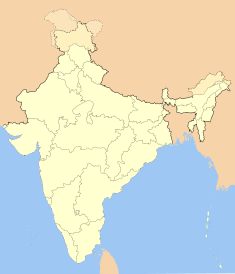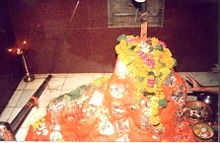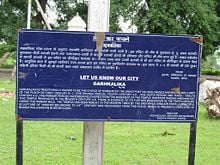Ujjain
| Ujjain Madhya Pradesh • India | |
| Coordinates: | |
| Time zone | IST (UTC+5:30) |
| Area • Elevation |
• 491 m (1,611 ft) |
| District(s) | Ujjain |
| Population | 429,933 (2001) |
Coordinates: Ujjain (Hindi: उज्जैन) pronunciation ▶ (also known as Ujain, Ujjayini, Avanti, Avantikapuri), an ancient city of Malwa in central India on the eastern bank of the Kshipra River (part of the state of Madhya Pradesh, is the administrative center of Ujjain District and Ujjain Division.
The epic Mahabharata speaks of Ujjayani as the capital of Avanti Kingdom during the ancient era, also serving as the first meridian of longitude for Hindu geographers since the fourth century B.C.E.. Ujjayani numbers among the seven sacred cities of the Hindus, with the Kumbh Mela religious festival held there every twelve years. Ujjain also serves as the home for Mahakaleshwar Jyotirlinga, one of the twelve Jyotirlinga shrines to the god Shiva.
History of Ujjain
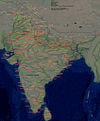
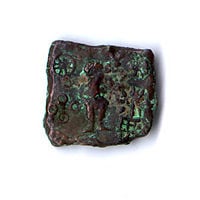
The earliest references to the city, as Ujjaini, come from the time of the Buddha, when it served as the capital of the Avanti Kingdom.[1] Since the fourth century B.C.E. the city has marked the first meridian of longitude in Hindu geography. Ujjain is reputed to have been the residence of Ashoka (who subsequently became the emperor), when he presided as the viceroy of the western provinces of the Maurya empire.
In the Post-Mauryan period, the Sungas and the Satavahanas ruled the city consecutively. The Satavahanas and the Ror Sakas (devotees of Shakumbari), known as Western Satraps contested for control of the city for a period. Following the end of the Satavahana dynasty, the Rors city retained Ujjain the from the second to the twelfth century C.E. Following the rise of the Gupta dynasty, the city soon became an important seat in the annals of that empire. Ujjain became the traditional capital of King Chandragupta II, also known as Vikramaditya, at whose court the nine poets known as the Navaratna (nine jewels) of Sanskrit literature inaugurated a golden age of Sanskrit literature.
In the sixth and seventh centuries, Ujjain became a major center of mathematical and astronomical research.[2] Famous mathematicians who worked there included: Brahmagupta, whose book Brahmasphutasiddhanta spread the use of zero, negative numbers and the positional number system to Arabia and Cambodia; Varahamihira, the first to discover many trigonometric identities; and Bhaskaracharya, or Bhaskara II, whose book Lilavati broke new ground in many areas of mathematics.
The Delhi Sultanate led by Iltutmish invaded Ujjain in 1235, bringing widespread destruction and systematic desecration of temples. Under the Mughal emperor Akbar it became the capital of Malwa.
During the last half of the eighteenth century, Ujjain served as the headquarters of the Maratha leader Sindhia.[3] The Scindias later established themselves at Gwalior, and Ujjain remained part of Gwalior state until Indian Independence in 1947. Gwalior state became a princely state of the British Raj after the Maratha defeat in the Third Anglo-Maratha War, and Gwalior, Ujjain, and the neighboring princely states became part of the Central India Agency. After Indian independence, the Scindia ruler of Gwalior acceded to the Indian Union, and Ujjain became part of the Madhya Bharat state. In 1956 Madhya Bharat merged into the Madhya Pradesh state.
Ancient monuments in Ujjain
Ujjain is an ancient city of central India, in the Malwa region of the Indian state of Madhya Pradesh, on the eastern bank of the Kshipra River. In ancient times the city was called Ujjayini. As per epic Mahabharata Ujjayani was the capital of Avanti Kingdom.
Following is a list of ancient monuments in Ujjain.
The Temples
Mahakaleshwar Jyotirlinga Temple
Mahakaleshwar Jyotirlinga is a famous Hindu temple dedicated to Lord Shiva and is one of the twelve Jyotirlingams, the sacred abodes of Shiva. It is located in the city of Ujjain in the Madhya Pradesh state of India. It is a three-storey temple, on the side of the lake called Rudra Sagar.
The main deity, shiva in the lingam form is believed to be swayambhu (born of itself), deriving currents of power (Shakti) from within itself as against the other images and lingams which are ritually established and invested with mantra-shakti. The idol of Mahakaleshwar is known to be dakshinamurti, facing the South. This is a unique feature, upheld by tantric tradition to be found only in Mahakaleshwar among the 12 jyotirlingas. The idol of Omkareshwar Shiva is consecrated in the sanctum above the Mahakal shrine. The images of Ganesh, Parvati and Karttikeya are installed in the west, north and east of the sanctum sanctorum. To the south is the image of Nandi. The idol of Nagchandreshwar on the third storey is open for darshan only on the day of Nag Panchami. The temple has five levels one of which is underground. The temple itself is located in a spacious courtyard surrounded by massive walls near a lake. The shikhara or the spire is adorned with sculptural finery. Brass lamps light the way to the underground sanctum.
Bade Ganeshji ka Mandir
This temple, situated above the tank near the Mahakaleshwar Temple, contains a huge artistic sculpture of Ganesha, the son of Shiva. An idol of this size and beauty is rarely to be found. The middle of the temple is adorned by an idol of the panch-mukhi (five-faced) Hanuman. There is a provision for learning of Sanskrit and Astrology in the temple.
Chintaman Ganesh temple
Chintaman means "the assurer of freedom from worldly anxieties". This temple is built across the Shipra(Kshipra) river on the Fatehabad railway line. The Ganesh idol in this temple is supposed to be swayambhu - born of itself. Riddhi and Siddhi, the consorts of Ganesha, are seated on either side of Ganesha. The temple is considered to be of considerable antiquity. The artistically carved pillars in the assembly hall date back to the Paramara period. The temple is about 15 km from the main city. Every Wednesday people come for special darshana.
Hara Siddhi Temple
This temple occupies a special place in the galaxy of ancient sacred spots of Ujjain. The temple is dedicated to Annapurna, seated between the idols of Mahalakshami and Mahasaraswati, the Annapurna is painted with a dark vermillion colour. The Shri Yatra, the symbol of power or shakti, is also enshrined in this temple. According to Shiva Purana, when Shiva carried away the burning body of Sati from the sacrificial fire, her elbow dropped at this place. There is an interesting legend in the Skanda Purana about the manner in which the Goddess Chandi acquired the epthet of Harassiddhi. Once whenShiva and Parvati were alone on mount Kailasha, two demons called Chanda and Prachanda tried to force their way in. Pleases Shiva bestowed upon her the epithet of Harasiddhi means 'one who vanquishes all'.
The temple was reconstructed during the Maratha period and has two pillars adorned with lamps, that are special features of Maratha art. There is an ancient well on the premises, and an artistic pillar adorns the top of it.
Kal Bhairava temple
The worship of the eight Bhairavas is a part of Saivite tradition, and the chief among them is Kala Bhairava. The Kal Bhairava temple is believed to have been built by King Bhadrasen, on the banks of the Shipra. Mentioned in the Avanti Khanda of the Skanda Purana. Important for the Tantric Kapalika and Aghora sects, of which Ujjain was a prominent centre. Beautiful paintings in the Malwa style once decorated the temple walls, only traces of which are visible. The village of Bhairogarh, famous for its printing, takes its name from the temple, and is located very near.
Mangalnath temple
Shiva or Mahadeva is the deity which is worshipped in Mangalnath temple. The Mangalnath temple is situated away from the bustle of the city and looks down upon a vast expanse of the Kshipra River. It is regarded as the birth place of Mars (mangala in Hindi), according to the Matsya Purana. Famous for a clear view of the planet and hence suitable for astronomical studies.
Gopal Mandir
Constructed by Bayajibai Shinde, the queen of Maharajah Daulat Rao Shinde, in the 19th century. The door in the inner sanctum is believed to have been carried to Ghazni from the Somnath temple and from thence by Mahmud Shah Abdali to Lahore, from where it was rescued by Mahadji Scindia.
Other temples
- Navagraha Mandir (Triveni) - A temple dedicated to the nine planets.
- Ram Janardhan Temple.
- Harihara Tirtha.
- Mallikarjuna Tirtha.
Pir Matsyendranath
This is very attractive spot on the banks of Shipra River, quite close to the Bhartrihari Caves and the Gadkalika temple. The shrine is dedicated to a leader of the Natha sect of Shaivism- Matsyendranath. It is also venerated by Muslims. Excavations here have yielded artifacts dating to the 6th and 7th century B.C.E.
Siddhavat
Features an enormous banyan tree on the banks of the Shipra, considered sacred since the medieval ages. This banyan tree has got the same significance as that of akshayavata in Prayag and Gaya, Vanshivata of Vrindavan and Panchavata of Nasik. Thousands of people take dip in the Shipra River from the bathing ghats built here. According to one tradition, Parvati is believed have performed her penance here. It used to be a place of worship for the followers of the Natha sect. The little village of Bhairogarh near Siddhawat is famous for its tie-and-die printing for centuries. In ancient times, when the trade with other counties flourished, exquisitely printed cloth from Bhairogarh used to find its way to Rome and China.
Bhartrihari Caves
Bhartrihari, the step brother of Vikramaditya, is believed to have lived and meditated here after renouncing worldly life. His famous works, Shringarshataka, Vairagyashataka, and Nitishataka, were possibly written here.
Kaliadeh Palace
It is situated on the banks of Shipra River and a beautiful ancient site. It is believed that there was once a majestic Sun temple at this site. The Avanti-mahatmya of Skanda Purana has recorded a description of the Sun temple and two tanks, The Surya Kunda and the Brahma Kunda. Remains of old temple are scattered all around. A fragmented inscription of this place records building of the palace in 1458 C.E., in the time of Mahmud Khilji. The central dome of the palace is a beautiful example of Persian architecture. Two Persian inscriptions record the visits of Akbar and Jehangir to this palace. The palace was broken by the Pindaris and was restored by Madhav Rao Scindia in 1920.
Sandipani Ashram
Ujjain in ancient times, enjoyed the reputation of being a great seat of learning as early as the Mahabharata period. According to Puranic traditions, in the Ashrama of Guru Sandipani, Krishna and Sudama received their education. The area near the ashrama is known as ankapata, popularly believed to have been the place used by Lord krishna for washing his writing tablet. The numerals 1 to 100 found on a stone are believed to have been engraved by Guru Sandipani. the Gomti Kunda, referred to in the Puranas, was the source of water supply to the ashrama in the olden days. An image of Nandi, belonging to the Shunga period, is to be found near the tank. The followers of the Vallabha sect regard this place as the 73rd seat of the 84 seats of Vallabhacharya where he delivered his discourses throughout India.
Durgadas Ki Chhatri
Durgadas fought for the independence of Jodhpur after the death of Maharaja Jaswant Singh and helped Ajit Singh to ascend the throne against the wishes of Aurangzeb. Durgadas died at Rampura in 1718 and his funeral rites were performed according to his wishes on the banks of Shipra River. The rulers of Jodhpur built the Chatri as Memorial to Durgadas, whose funeral rites were performed at this place in 1718. This structure built in Rajpur style of architecture, housed a statue of Durgadas which crumbled down.
Gadkalika
Gadkalika, situated about two miles from the present town, the deity in this temple is believed to have been worshiped by Kalidasa. The legend goes that he was an idiot and it is by this devotion to the goddess Kalika that he acquired great literary skill. Believed to have been frequented by Kalidasa, this temple was renovated by Harshavardhan in the 7th century AD, and again during the Paramara period. The temple has been rebuilt in the modern times by the erstwhile Gwalior State.
Other places
- Vedhashala - An observatory built by Raja Jai Singh II (1686-1743). It is located at . It is still in use, and is one of the five he built (the others include the Yantra mandir (Jaipur) and the Yantra Mandir (Delhi).
- Ram Ghat.
- Ganga Ghat.
- Bohron Ka Roja.
- Begum Ka Maqbara.
- Bina Neev Ki Masjid.
- Maulana Rumi Ka Maqbara.
Gallery
- Kalabhairava Temple Ujjain.JPG
Kalabhairava Temple Ujjain
- Mahakal Jyotirlinga Ujjain.JPG
Mahakal Jyotirlinga Ujjain
- Bhadrakali Ujjain.JPG
Bhadrakali Temple Ujjain
Various Names of Ujjain
Since Ujjain is one of the oldest cities in India, it has been known by very many names, among which were:[5]
- Avantika
- Padmavati
- Kushasthali
- Bhagavati
- Haranyavati
- Kandakatringa
- Kumudvati
- Pratikalpa
- Ujjayani
- Vishala
Geography
Ujjain is situated on the Malwa Plateau in Central India. The soil is black and stony. The vegetation is typical of arid regions with thorny trees like babul and acacia dominating the landscape. Soybean, wheat, jowar and bajra are the main crops grown.
Ujjain is located at .[6] It has an average elevation of 491 metres (1610 ft).
Demographics
As of 2001 India census, Ujjain had a population of 429,933.[7] Males constitute 52% of the population and females 48%. Ujjain has an average literacy rate of 72%, higher than the national average of 59.5%: male literacy is 79%, and female literacy is 66%. In Ujjain, 13% of the population is under 7 years of age.
Climate
Ujjain experiences typical climate conditions of the interior Indian subcontinent. The summer months (April–June) are harsh with temperatures reaching up to 45°C. In addition, hot winds (called loo) may blow in the afternoons, worsening the heat. The winter months (Nov.–Feb.) are pleasant and cool with daytime temperatures typically 20°C, though it may drop to 3°C in the night. The monsoon typically arrives in late June and the months of June till September receive moderate to heavy rainfall. There are periods of rainfall followed by long periods of bright sunshine and high humidity. The month of October generally is very warm and with high humidity.
Administrative
Ujjain city has two legislative assembly zones, known as Ujjain North and Ujjain South. For Parliamentary purposes it is treated as one seat
Economy
The economy of Ujjain is mainly dependent on the agricultural activities of the nearby villages. Two main crops are grown each year: wheat as the major Rabi crop, soyabean as the major Kharif crop. Ujjain agriculture is sensitive to changes in rainfall and failure of monsoon cycles can lay a devastating toll on agriculture and the local economy.
Ujjain was previously a centre of the textile industry with a number of textile mills in and around the city. These mills have since closed, unemploying hundreds. Religious tourism is also a contributor to the economy, especially during the Simhasta Mela.
Commercial Zones
One good thing about the old city is that the market is quite organized. For utensils you have the Patni Bazaar, for jewellery; Sarafa, for grocery; Daulat Ganj, for clothes; VD Cloth Market, Kanthal.
There are various shopping areas like Freeganj, Gopal Mandir, and Satigate.
Freeganj is a rapidly growing area, complete with relatively better modern amenities.
Transport
Ujjain is well-connected by rail and road. It is on the Western Railway and is connected by direct train to most major Indian cities (Mumbai, Delhi, Hyderabad,Chennai, Kolkata, Bangalore, Ahmedabad, Pune, etc).
The nearest airport is Indore, which has daily flights to Delhi, Mumbai, Kolkata,Ahemdabad,Bangalore & Bhopal.
The road network is developed with other parts of Madhya Pradesh. Private buses ply on these roads, though it is best to take your own vehicle for short distances.
An extensive network of old but inexpensive three-wheelers called tempoes serves the majority of the population. Three-wheeler auto-rickshaws are also quite popular. Recent years have seen an explosion of privately owned vehicles, especially two-wheelers unsuited for the traffic, that congest the narrow thoroughfares.
Railway Stations
There are three well-known railway stations:
- Ujjain City Junction
- Vikram Nagar
- Chintaman (metre gauge)
Bus Stations
- Dewas Gate
- NanaKheda
Major Roads
Indore Road, Dewas Road, Agar Road, Badnagar Road, Maksi Road,Ankpat marg,CASE road (in GECU), Mahakal Vainjya Kendra, Panditji Choraha, ISKCON temple,sanver road,
Education
Ujjain city is well known for its university Vikram University which is the main institution of higher education in the city. Besides the university, Ujjain also has different colleges and institutes where students can pursue various courses.
Schools in Ujjain
- St Paul's Higher Secondary School
- Ujjain Public School(UPS)
- Lokmanya Tilak Higher Secondary School[1]
- Kendriya Vidyalaya Ujjain
- Takshshila Junior College
- Christu Jyoti Convent Senior Secondary School
- Kalidas School bambakhana
- Stanford International Girls School
- Gyan Sagar Academy
- The Cambridge H.S.School
- Bhartiya Gyan Peeth Higher Secondary School and College
- Saraswati Vidhya Mandir
- Model Higher Secondary School
- Oxford Junior college(OJC)
- Study Home School (SHS)
- Rohet Children's Academy
- Crown Public School Ujjain
- Gujrati Samaj Higher Secondary School,Nai Sadak
- St. Mary's Convent School
Engineering Colleges in Ujjain
- Government Engineering College, Ujjain (GECU)
- Mahakal Institute of Technology (MIT)
- Mahakal Institute of Technology and Sciences (MITS)
- Mahakal Institute of Technology and Management (MITM)
- Mahakal Institute of Management (MIM)
- Mahakal Institute of Pharmacutical & Sciences(MIPS)
- Alpine Institute of Technology (AIT)
- Prashanti Institute of Technology and Sciences (PITS)
- Guru sandipani Institute of Technology(GSIT)
- Ramotidevi Institute of Technology
Medical Colleges in Ujjain
- Govt. Autonomous Dhanvantri Ayurved College
- R.D.Gardi Medical College ujjain
Management Colleges in Ujjain
- Jawaharlal Nehru Institute of Business Management(JNIBM)
- Mahakal Institute of Management(MIM)
- ICFAI FLP (1st floor sunshine tower)
- Maharaja Institute of information & Technology
- Alpine Institute of Management[8]
See Also
- Malwa (Madhya Pradesh)
- Vikramāditya
- Maurya Empire
- Sunga Empire
- Brahmagupta
- Religion in India
- Hinduism
Notes
Links retrieved November 22, 2008.
- ↑ Vincent A. Smith, The early history of India from 600 B.C.E. to the Muhammadan conquest including the invasion of Alexander the Great (Oxford: Clarendon Press, 1914), p. 325
- ↑ Dirk Jan Struik, A concise history of mathematics (New York: Dover Publications, 1987), p. 66.
- ↑ G. S. Chhabra, Advanced study in the history of modern India (New Delhi: Sterling Publishers, 1971), v. 1, p. 302
- ↑ Kenneth William Morgan, The religion of the Hindus (Delhi: Motilal Banarsidass, 1987), p. 189.
- ↑ Adrian Room, Placenames of the world: origins and meanings of the names for over 5000 natural features, countries, capitals, territories, cities and historic sites (Jefferson, N.C.: McFarland, 1997) , p. 12.
- ↑ Falling Rain Genomics, Inc - Ujjain
- ↑ Scholastic Library Publishing, Encyclopedia Americana (Danbury Conn: Scholastic Library Pub., 2005), p. 342.
- ↑ Alpine Ujjain
ReferencesISBN links support NWE through referral fees
- Chhabra, G. S. 1971. Advanced study in the history of modern India. New Delhi: Sterling Publishers. OCLC 247623.
- Morgan, Kenneth William. 1987. The religion of the Hindus. Delhi: Motilal Banarsidass. ISBN 9788120803879.
- Room, Adrian. 1997. Placenames of the world: origins and meanings of the names for over 5000 natural features, countries, capitals, territories, cities and historic sites. Jefferson, N.C.: McFarland. ISBN 9780786401727.
- Scholastic Library Publishing. 2005. Encyclopedia Americana. Danbury Conn: Scholastic Library Pub. ISBN 9780717201389.
- Smith, Vincent A. 1914. The early history of India from 600 b. C. to the Muhammadan conquest including the invasion of Alexander the Great. Oxford: Clarendon Press. OCLC 174877753.
- Struik, Dirk Jan. 1987. A concise history of mathematics. New York: Dover Publications. ISBN 9780486602554.
External Links
Links retrieved November 22, 2008.
- Holy City of Ujjain
- Mahakaleshwar Mandir
- Ujjain
- Research: Ujjain
- The Simhastha Kumbh of Ujjain
- Kumbha Mela at the Shipra River
- Ujjain
Credits
New World Encyclopedia writers and editors rewrote and completed the Wikipedia article in accordance with New World Encyclopedia standards. This article abides by terms of the Creative Commons CC-by-sa 3.0 License (CC-by-sa), which may be used and disseminated with proper attribution. Credit is due under the terms of this license that can reference both the New World Encyclopedia contributors and the selfless volunteer contributors of the Wikimedia Foundation. To cite this article click here for a list of acceptable citing formats.The history of earlier contributions by wikipedians is accessible to researchers here:
The history of this article since it was imported to New World Encyclopedia:
Note: Some restrictions may apply to use of individual images which are separately licensed.
